I grew up in Lewisville, Texas–a suburb of Dallas located in southeast Denton County. We moved there in the early 1970s, back when Lewisville was still little more than a rural farming town. Our new house was part of a subdivision that was growing up on the west side of the city–way out on Main Street, well past its intersection with Interstate 35 East.
Just a little further to the west of our neighborhood was the city line, where Lewisville bumped up against the even smaller township of Flower Mound. The little rural community of Flower Mound began where Lewisville ended and followed the north shore of Grapevine Lake out past the place where Farm to Market Road FM 1171 met US Highway 377, ultimately covering some 20,000 plus acres.
In Flower Mound–just across the city line from our neighborhood–there was another new subdivision under construction. At the time, Flower Mound was made up mostly of farms, ranches, and rural homesteads, but this subdivision near Lewisville was a little different. Even as a kid I could tell there was something unusual about the neighborhood–though I would have been hard pressed back then to identify just what the difference was.
Timber Creek Community was the name of this development, and every now and again we would have occasion to pass through or visit the neighborhood. The subdivision had a nice big public park that we enjoyed. The park was centered around a large lake, and included walking trails, tennis courts, and a half Olympic-sized indoor swimming pool. The Lewisville Independent School District had a new and modern-looking administration building on this same site as well (Both the pool and the office building have been torn down some time in the intervening years).
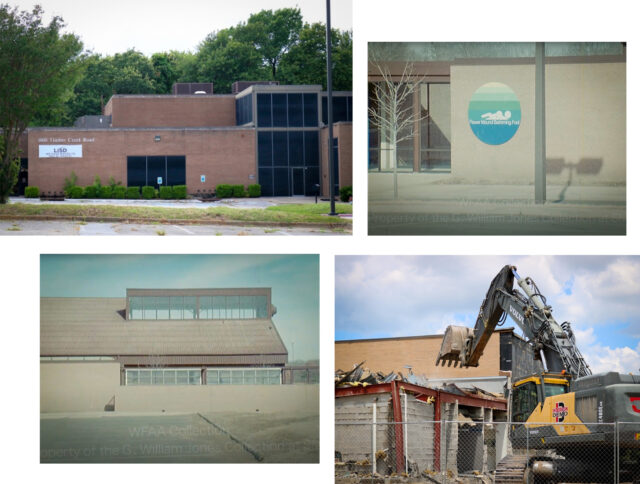
and the demolition of the newer LISD natatorium.
Click Image to Enlarge
The community of Timber Creek had been constructed centered around this big public park. Entrance into the neighborhood was facilitated by a broad boulevard, which branched off into side streets and cul-de-sacs, that sometimes included extra parking areas for visitors and residents. The houses were built in a more contemporary style than than was the usual in other Lewisville and Flower Mound neighborhoods. Every residential block was equipped with a big community mailbox. Playground parks were uniquely constructed of timber and metal pipes. The signage and streetlights for the neighborhood were also different than anywhere else in town–they were brown in color and had a minimalist, modern look about them. In spite of all this, Timber Creek had a noticeable unfinished feel to it–there appeared to be a little more infrastructure than the community seemed to need.
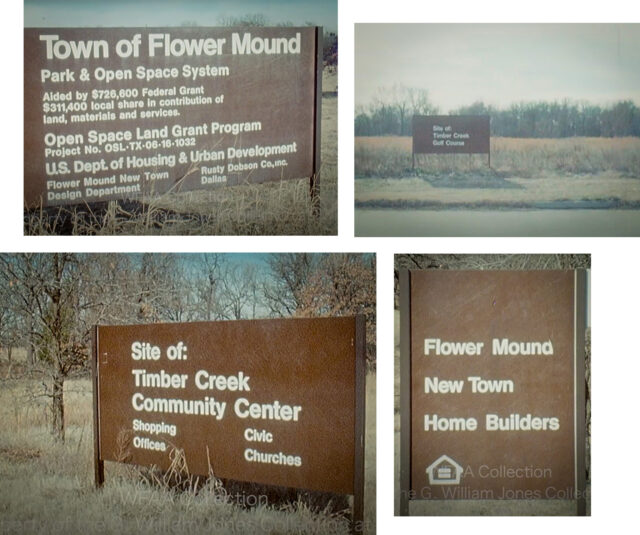
Click Image to Enlarge
As I recall, every time we happened to pass through Timber Creek, the slightly unusual aspects of the neighborhood would register with me. From time to time over the years that followed, I would catch myself wondering about the neighborhood’s backstory. Was there really something different here, or was I just reading too much into it?
Well–as they are apt to say on the internet–I was this many years old when I finally discovered a clue! One day recently–just by chance–I noticed a Facebook post referencing something called “Flower Mound New Town.” The post include a rough architectural drawing that piqued my curiosity, so I threw caution to the wind and clicked the link. The article that appeared on my computer screen referenced Flower Mound New Town at only a very high level, almost as if its existence was common knowledge. I had to pull on that thread a little bit to discover other articles and stories about this real estate development, and soon the full story began to be revealed. In short order, I had teased out many of the important details.
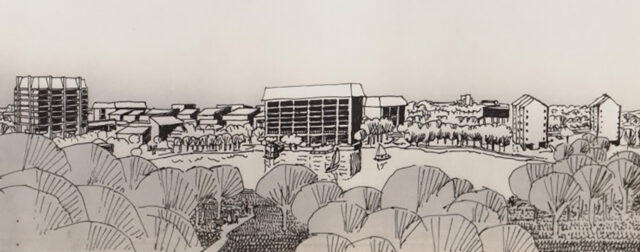
It would seem that during the LBJ Administration in the 1960s, the federal government launched initiatives to create new and modern communities near some of the country’s larger urban centers. The program matured into the National Urban Policy and New Community Development Act of 1970 which was designed to provide financial support for New Town developments through the Department of Housing and Urban Development. The plan funded development of some thirteen New Town projects in various parts of the United States.
Flower Mound New Town was to be one of these new, forward-looking communities. Here in North Texas, Edward S. Marcus of Neiman Marcus fame teamed up with the Nasher Company to pursue this development project. Marcus had owned land in Flower Mound since the 1950s, and had likely eyed developing it for some time. Years later Flower Mound would memorialize his contributions by naming its first high school after him.
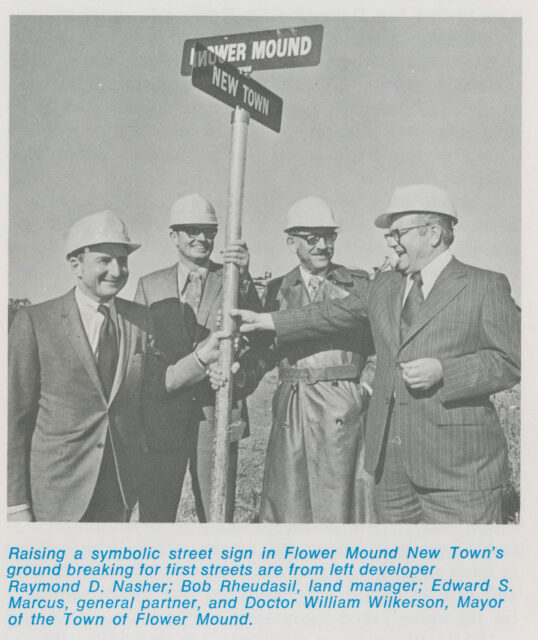
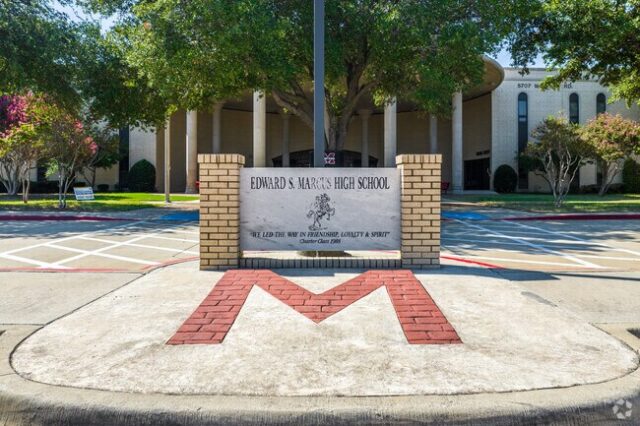
Marcus’ plan was to develop a master planned community that would eventually support populations of around 60,000 to 70, 000 people. Construction was expected to be ongoing for 18 to 20 years before the project would complete. Environmental considerations called for large areas of green spaces, earmarking one of every five acres to be designated as parkland or to be left undeveloped. The ambitious design included advanced (for the time) infrastructure, with fully networked and computerized fire, medical, and security monitoring for the entire community. All homes and businesses would be wired for cable TV. The developers planned to include everything Flower Mound New Town would need–housing, shopping, medical, fire and police, churches, athletics, and entertainment.
But, things didn’t work out as planned for Flower Mound New Town. An Economic downturn in the early 1970s caused the project to stumble right out of the gate. Flower Mound city government also had trouble garnering requisite support from residents living in other parts of the town. By 1976, federal urban planning priorities had shifted to the inner cities, and the Flower Mound New Town project was terminated, and then foreclosed on by the Department of Housing and Urban Development.
Flower Mound New Town was quickly forgotten. I never one time remember hearing anyone talk about in all the years I lived there in close proximity. After the development was foreclosed on by the Department of Housing and Urban Development, the property was parceled off in smaller chunks to other developers. Eventually, by the 1980s, organic development reached the part of Flower Mound that had been earmarked to be New Town. The subdivision begun under the auspices of Flower Mound New Town was renamed to Timber Creek, and over time it was finally completely built out. The town of Flower Mound has since boomed, and the rapid development of the surrounding area completely absorbed Flower Mound New Town. With a total current population of well over 75,000 Flower Mound is now a thriving and prosperous upscale suburb of Dallas/Fort Worth.
More Information
UNT LIBRARIES – Flower Mound New Town
UNT LIBRARIES – The Model Cities Program
WIKIPEDIA – National Urban Policy and New Community Development Act of 1970
TEXAS ARCHIVE – Flower Mound New Town Commercial
YOUTUBE – KERA Profile On The Creation Of Flower Mound New Town – Early 1970s
YOUTUBE – Plans for Flower Mound New Town – November 1974
YOUTUBE – Flower Mound New Town Development Becomes Timber Creek – January 1977
FACEBOOK – 1978 New Town Flower Mound, TX. HUD put Flower Mound up for sale. Town of Flower Mound
NEW YORK TIMES – Edward S. Marcus, Ex‐Chairman Of Neiman‐Marcus Stores, at 67
UNT LIBRARIES – Raymond D. Nasher: A Northerner’s Contributions to Dallas-Fort Worth
TEXAS STATE HISTORICAL ASSOC – History of Flower Mound, Texas: From Settlement to Suburban Growth
COMMUNITY IMPACT – Demolition work at former Lewisville ISD natatorium to Begin
HUD NEWS – History of the New Communities Act PDF






